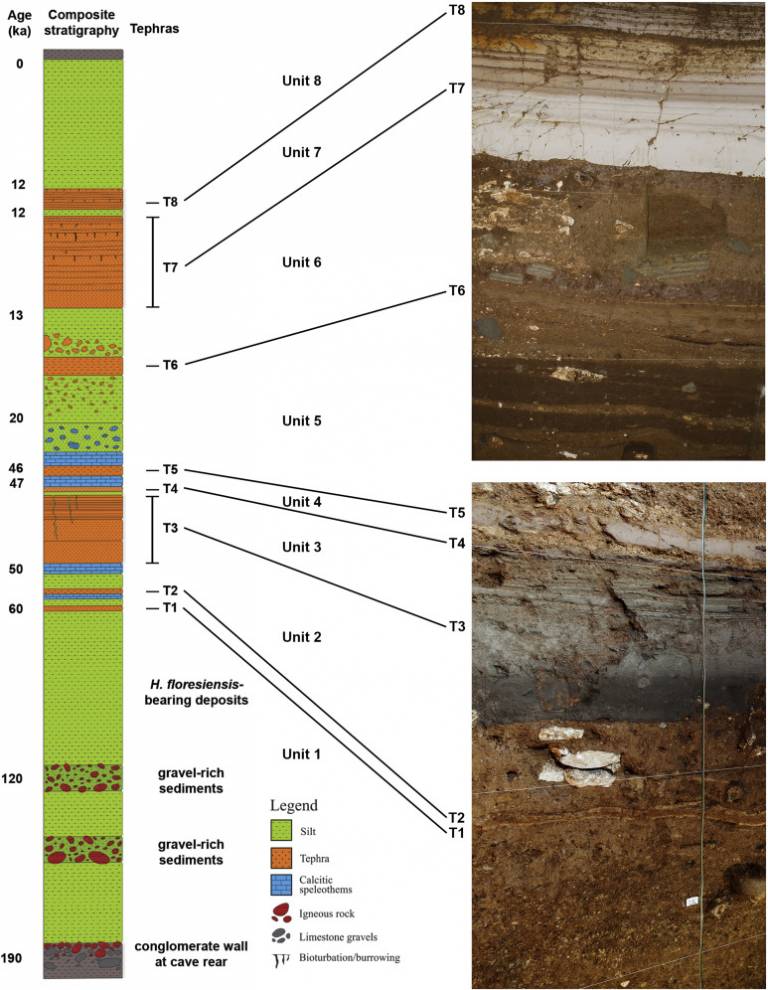Increased use of Chert around 46,000 years ago, suggests the first arrival of Homo sapiens on the island of Flores, Indonesia
6 November 2018
Liang Bua, the type site of Homo floresiensis, is a limestone cave on the Indonesian island of Flores with sedimentary deposits currently known to range in age from about 190 thousand years (ka) ago to the present.
 Recent revision of the stratigraphy and chronology of this depositional sequence suggests that skeletal remains of H. floresiensis are between ∼100 and 60 ka old, while cultural evidence of this taxon occurs until ∼50 ka ago. Here we examine the compositions of the faunal communities and stone artifacts, by broad taxonomic groups and raw materials, throughout the ∼190 ka time interval preserved in the sequence. Major shifts are observed in both the faunal and stone artifact assemblages that reflect marked changes in paleoecology and hominin behavior, respectively. Our results suggest that H. floresiensis and Stegodon florensis insularis, along with giant marabou stork (Leptoptilos robustus) and vulture (Trigonoceps sp.), were likely extinct by ∼50 ka ago. Moreover, an abrupt and statistically significant shift in raw material preference due to an increased use of chert occurs ∼46 thousand calibrated radiocarbon (14C) years before present (ka cal. BP), a pattern that continues through the subsequent stratigraphic sequence. If an increased preference for chert does, in fact, characterize Homo sapiens assemblages at Liang Bua, as previous studies have suggested (e.g., Moore et al., 2009), then the shift observed here suggests that modern humans arrived on Flores by ∼46 ka cal. BP, which would be the earliest cultural evidence of modern humans in Indonesia.
Recent revision of the stratigraphy and chronology of this depositional sequence suggests that skeletal remains of H. floresiensis are between ∼100 and 60 ka old, while cultural evidence of this taxon occurs until ∼50 ka ago. Here we examine the compositions of the faunal communities and stone artifacts, by broad taxonomic groups and raw materials, throughout the ∼190 ka time interval preserved in the sequence. Major shifts are observed in both the faunal and stone artifact assemblages that reflect marked changes in paleoecology and hominin behavior, respectively. Our results suggest that H. floresiensis and Stegodon florensis insularis, along with giant marabou stork (Leptoptilos robustus) and vulture (Trigonoceps sp.), were likely extinct by ∼50 ka ago. Moreover, an abrupt and statistically significant shift in raw material preference due to an increased use of chert occurs ∼46 thousand calibrated radiocarbon (14C) years before present (ka cal. BP), a pattern that continues through the subsequent stratigraphic sequence. If an increased preference for chert does, in fact, characterize Homo sapiens assemblages at Liang Bua, as previous studies have suggested (e.g., Moore et al., 2009), then the shift observed here suggests that modern humans arrived on Flores by ∼46 ka cal. BP, which would be the earliest cultural evidence of modern humans in Indonesia.
The spatio-temporal distribution of archaeological and faunal finds at Liang Bua (Flores, Indonesia) in light of the revised chronology for Homo floresiensis
Thomas Sutikna, Matthew W. Tocheri, J. Tyler Faith, Jatmiko, Rokus Due Awe, Hanneke J. M. Meijer, E.Wahyu Saptomo, Richard G. Roberts
DOI: 10.1016/j.jhevol.2018.07.001
 Close
Close

